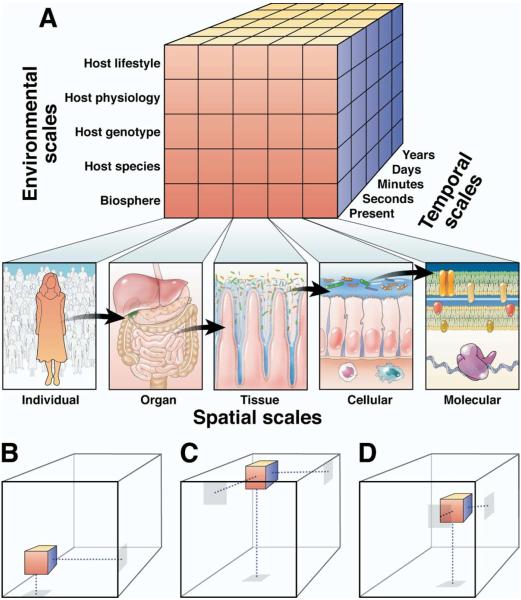Figure 1.
Scales in GI microbial ecology. (A) The GI ecosystem can be conceptualized as a 3-dimensional space defined by variation along environmental, spatial, and temporal scales. Environmental scales (y-axis) are defined by different types of variation affecting the GI environment, including variation in biosphere, host species, host genotype, host physiology, and host lifestyle. Spatial scales (x-axis) are defined by the spatial resolution at which the GI ecosystem is perceived. The upper macroscopic level consists of the individual host and progresses down through the levels of organ system, tissue, cell, and molecule. Note that the molecular spatial scale is illustrated here by molecules within a gram-negative bacterium, although this same scale can be applied to molecules of any host or microbial origin. Temporal scales (z-axis) are defined by the time over which variation in the GI ecosystem is perceived, beginning with the present and progressing into seconds, minutes, days, and years. B–D show how this conceptual frame of reference can be used to provide context for 3 recent studies of the GI ecosystem. B depicts a phylogenetic comparison of the microbial community in the feces (spatial scale: organ) of different mammalian host species (environmental scale: host species) at a single time point (temporal scale: present).98 C depicts a phylogenetic comparison of the microbial community in the feces (spatial scale: organ) of individual healthy humans at multiday intervals (temporal scale: days) before and after treatment with the antibiotic ciprofloxacin (environmental scale: host lifestyle).50 D depicts a comparison of bacterial cell behavior (spatial scale: cells) in zebrafish intestines at different stages of development (environmental scale: host physiology) using real-time in vivo imaging (temporal scale: seconds).83

